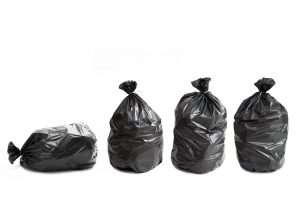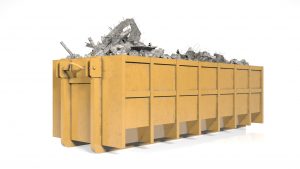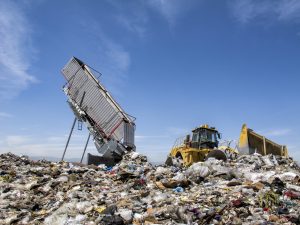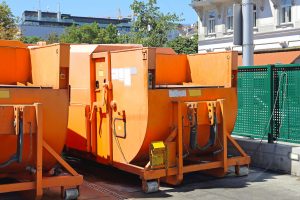by CharlieB | Feb 23, 2017
 In the future, robots and other machines will handle all of our waste Picture “The Jetsons.” Picture the Death Star trash compactor in “Star Wars.” Handling and disposing of the garbage falls entirely on someone else, and we never need to touch it again. Wouldn’t that be lovely? Unfortunately, that future is probably a long ways off. So what can we do in the present?
In the future, robots and other machines will handle all of our waste Picture “The Jetsons.” Picture the Death Star trash compactor in “Star Wars.” Handling and disposing of the garbage falls entirely on someone else, and we never need to touch it again. Wouldn’t that be lovely? Unfortunately, that future is probably a long ways off. So what can we do in the present?
Well, KenBay is all about proper waste disposal, but that doesn’t mean we think handling waste all the time is good either! When you’re trying to get rid of your trash, it’s better to be quick, fast, and done. So, here are some ways to reduce handling when handling waste.
Do Away With Boxes
Oh boxes, so essential to our everyday life and, paradoxically, so wasteful. Boxes are a bit of a trap, waste wise, because every time you order more, you’re just adding to the waste! There are some cool ideas to reduce boxes, like this nifty little invention. But nothing has really taken off yet to do away with the hundreds of billions of boxes created each year.
True, you can recycle the cardboard, and indeed most people do. But you still need to find a place to put the boxes. Not to mention, most of them are on the small side. If you’re using boxes to hold your temporary waste, you probably need to make a lot of trips! A better solution would be something like Super Sacks, which are larger and can hold up to 4000 lbs of waste. They can also be reused if you’re careful with them, and they are easy to recycle just like cardboard!
Place Compactor at the Source of the Waste
Of course, one of the biggest time wasters when handling waste is having to travel on your factory floor to the compactor itself. Keep in mind, you’re probably carrying an armful of junk too, inhibiting your movement and your vision. This is a workplace hazard! A better answer is to have a smaller compactor, when you can place right at the source of the waste. Finished with that cardboard or edge trim? Great! Just toss it into the compactor and keep moving, no muss or fuss.
Compact and Stack
Finally, when you are handling waste, you want to make the fewest amount of trips possible. For one thing, nobody wants to go back and forth just for garbage. For another thing, as previously mentioned, it’s a workplace hazard. So how to you get more trash to the truck, quicker? Easy! Buy a compactor that presses the garbage into a cube shape. The cubes of trash can be more easily loaded into something like a super sack or a lift.
KenBay does all of this for you! Our RotoPac compactors are small enough to be used on site. And our continuously rotating arm presses the waste together into those nice neat little cubes. We may not be living in the future, but we have the answers you need today!
If you want to try out a RotoPac for yourself, then you can make a request and we’ll send one to you! And if you decide you like it, simply pay the money to keep what we’ve sent!
by CharlieB | Jan 19, 2017
So you’ve finally decided that your plant is going to be more environmentally responsible. You’re no longer going to put concerns of waste off to the side of your mind. Instead, you’re going to be conscious about separating your recyclable items from the non-recyclables. Hey, we salute you! KenBay is committed to a zero waste initiative and helping others achieve the same goals. We believe that it is the responsibility of business owners and managers to handle their waste and recycling responsibly.
One of the first concerns raised when it comes to recycling is cost, especially the cost of transporting the recyclable items. This is understandable! You want to protect the environment and be socially conscious, but you also can’t allow it to be too big of a strain on your business. Fortunately, there is a solution! You can transport your recyclable items and still save money! Here’s how!
Compact Your Recyclable Items into a Convenient Cube!
One of the first and most important things you can do is make sure your recyclable items are the right shape. It may be cheaper to toss it all into a garbage bag but there are two problems. One: if you are throwing away all that garbage bag plastic anyway, is there a point to adding it to the recycling truck? Two: that is not the most cost effective use of your space. You’re leaving large gaps of air in the truck, air which you are now paying to transport!
A better solution is to use a trash compactor to press all that garbage into a convenient cube shape. The cube allows for trash that is more easily stackable. Basic geometry, really! And wouldn’t you know it, KenBay has our line of handy and transportable compactors all ready to go!
Square Bags are Great Too!
Speaking of shapes, the right kind of bag can make all the difference when it comes to transportation! When you have square cubes, it just makes sense to put them in a square bag. Again, it comes down to making everything more stackable and reducing the amount of air you are hauling. Personally, we recommend super sacks. They’re fairly durable, and you can also recycle them too!
Choose KenBay and get Everything You Need
Like we said before, a KenBay compactor is a great way to press your garbage and your recyclable items into the right shape for transport. We have a variety of compactors for whatever your waste needs are. Whether they are hazardous materials, volatile waste, or even marine waste, we have the right product for you. We also offer a line of biodegradable waste compactor bags for your convenience! So if you are ready to make the switch to KenBay today, then please visit our website. There, you’ll find our full range of products to check out for yourself. You can try one of the products before you buy it. If you like what you see, then no problem! Keep the compactor that we send you and pay the difference!
by CharlieB | Jan 12, 2017
 If someone were to ask you how much you spend on trash disposal for your home, would you know the answer? Perhaps you do, because for most of us that cost is around $10 to $40 per month, or a couple hundred per year. At that low price, you can see how one might take waste collection for granted. It’s far too easy to get into a routine of leaving the garbage out on the curb for someone else to handle. I can certainly say that I’ve let it slip my mind!
If someone were to ask you how much you spend on trash disposal for your home, would you know the answer? Perhaps you do, because for most of us that cost is around $10 to $40 per month, or a couple hundred per year. At that low price, you can see how one might take waste collection for granted. It’s far too easy to get into a routine of leaving the garbage out on the curb for someone else to handle. I can certainly say that I’ve let it slip my mind!
Well business and manufacturing plant owners don’t really get that luxury. Trash disposal and handling is integrated into their yearly budget. Far from a couple hundred, they are usually paying upwards of $900 depending on their location. Suddenly it’s not so easy to let trash disposal slip your mind, is it? KenBay understands that plight and want to help! If you are looking to increase savings without sacrificing your environmental integrity, this week’s blog is for you. Here are some great ways to cut costs out of industrial trash disposal.
How Much Does Your Trash Cost?
Besides the average cost of living in your location, there are actually a lot of contributing factors to the cost of your waste management. Some key ones include the volume of the waste as well as the specific types you are getting rid of. Certain materials are more difficult to dispose of than others. Other factors include the cost of manpower, fuel for the trucks, and the number of trips between the dump and your factory. Add it all together and it’s no wonder that garbage gets so costly over time!
Good News for Your Trash Disposal
You may be sweating, considering how many small factors could end up contributing to such a big debt. But here is the good news: you can control almost all of the ones I just mentioned! The best way to reduce your trash volume is, of course, reusing and recycling. You aren’t hauling what doesn’t need to be thrown out, after all. As to the other factors, we here at KenBay can offer some assistance with them!
See, a KenBay RotoPac is ideal for compacting your waste because it is small and has a high level of compaction. Its size means that it is more portable than a regular compactor, and can be used right at the source of your waste! This means less handling and less money spent towards manpower. Additionally, a KenBay RotoPac continually presses all your waste into tight airless cubes. These cubes are more stackable, and allow you to fill up more of the truck. Remember, you are paying for volume, not weight! The less of that volume is filled with air, the more money you are saving. This in turn saves money on fuel, since you are making fewer trips!
If you think a KenBay RotoPac is the trash disposal answer you’ve been looking for, then check out our website. We have a wide selection of RotoPacs to fit any waste need. You can try a RotoPac before you choose to buy it, and we will send it to your site. If you like it, simply pay to keep the one we already sent you! Start seeing the savings, with KenBay!
by CharlieB | Dec 5, 2016
 Is there anything sexier than watching something be squished into a nice geometrical cube? Look at this video and tell me I’m wrong. Alright, maybe “sexy” is not quite the right term for it, but compaction is still incredibly cool. Besides being the adult equivalent of smashing up your Play-Doh creations, compacting your waste is also a great way to be responsible about your environmental impact.
Is there anything sexier than watching something be squished into a nice geometrical cube? Look at this video and tell me I’m wrong. Alright, maybe “sexy” is not quite the right term for it, but compaction is still incredibly cool. Besides being the adult equivalent of smashing up your Play-Doh creations, compacting your waste is also a great way to be responsible about your environmental impact.
There are a lot of benefits to compacting waste, stuff you probably haven’t ever thought about. Maybe you’re already compacting and never thought about it before. Maybe you’re not compacting and wondering why you should bother. What does it matter to you how the waste looks? It all ends up in the same place anyway, right? Sorry, but that’s simply not true. Compaction offers a lot of great benefits to your plant, and you should be doing it. Want to know why? Then check these tips from KenBay!
Compaction Reduces Hauling Costs
Think of your big pile of waste like it’s on last call at a bar: “You don’t have to go home, but you can’t stay here.” Your waste has to go somewhere, and if you’re an environmentally conscious organization you know better than to dump it in a natural resource. So, at some point you’re going to have to haul it on out of there. The trouble is getting all your waste to fit. Because here’s the thing: if you’re just dumping it all onto the truck as is, you know what you’re doing? You’re wasting space. That junk doesn’t just fit together like a nice little puzzle piece! And you know what you’re still paying for? All that air that gets hauled to the dump along with your waste. Which means you can add one more thing you’re wasting: money!
Compacting your junk makes it so that you are turning it into a puzzle piece. One where each piece is shaped like nice little easily-stackable cube. This video shows just how much trash can be hauled when it’s all compacted together. Get more junk on the truck, and pay for less air. It’s that easy!
Compaction Improves Safety
If you’re working in a plant, then you know how dangerous scrap metal can be. It’s sharp and it needs to be handled carefully and consciously. You know what isn’t careful or conscious? Throwing it all onto a big truck. You run risks of slicing open your hand both loading and unloading that metal. Compacting it into a cube shape is safer because you’re helping to reduce those sharp edges. Also, the cubes can be easily stacked onto a fork lift, so you’ll have less time handling it at all! (Sorry.)
Compaction Reduces Labor
Hey, here’s another great way to save money: quit paying for hours and hours of labor to load, transport, and unload the truck. Small, compacted cubes are far easier (and require less manpower) to load and unload, meaning you don’t spend nearly as much money on outside junk haulers. Those savings build up over time!
We hope you agree that compacting your junk is definitely the way to go. And you know what else? KenBay has the machines needed to get the job done. Our RotoPacs are compact and can be used right at the source of the junk, and they leave a small footprint. You can try one out for yourself if you don’t believe us! Then, maybe you’ll agree that compacting can be sexy after all.
by CharlieB | Oct 28, 2016

They say that necessity is the mother of invention. Every great, long-lasting improvement in technology came about because there was a need for it. We needed faster ways of transportation, so the car was invented. Drivers couldn’t see in the rain, so windshield wipers were devised. All throughout history are examples of ingenuity rising up to solve a problem. Well, one modern day problem for plant workers is how to properly get rid of waste like label matrix trim. It needs to be disposed of, and there are a many machines built just for that purpose. But trim removal systems can occasionally jam if running too quickly, and clogged machines mean wasted time and money. Plant personnel have gotten very creative when it comes to dealing with label matrix disposal. Everything from shredding to actually devising ways to use it in the machine itself. We here at KenBay have a better idea: don’t deal with it at all! Simply throw the label matrix directly into a continuous compactor at the source of the waste. Just bag it and dump it!
Why a Continuous Compactor?
You’re probably familiar with a traditional trash compactor. They’re large, they smell bad, and they are normally triggered by opening and closing the door three times. If your plant is already using one, why is a continuous compactor better?
For one thing, a continuous compactor never needs to be manually switched on. It’s right there in the name, continuous. It never shuts off on its own! A constantly rotating arm keep pressing down whatever you throw into it into neat and tidy and stackable cubes. The shape of these cubes is another great thing about continuous compactors — you’re never paying to haul around any unnecessary air when you’re getting rid of your waste. Just stack the cubes up and fill more space on the junk hauler!
Another issue is safety. We mentioned that traditional compactors are big, right? Often they’re so large that they’re immovable without additional machinery. Once you set them down, they’re not going anywhere. What does this mean for you and your employees? It means that whenever you have something like a label matrix that you need to trash, you need to leave your station and move there physically. I don’t need to tell you the risk of walking around an area with heavy active machinery! Smaller continuous compactors can be placed right at the worksite, so you can just toss the label matrix trim in when you need to and continue on with the work. In short, it helps to reduce unnecessary risk.
KenBay Helps You Manage Label Matrix Disposal
KenBay has a wide variety of inexpensive continuous compactors that are portable and easy to handle. Because they have a small footprint, it is easy to have multiple compactors at key waste disposal sites. Our line of products not only offer a safer solution to waste disposal, they are efficient as well. You won’t squander unnecessary time disposing of your waste, and you won’t pay extra money to haul air to the landfill. If you are interested in having a continuous compactor for your plant, contact us to try it before you buy it. Discover the difference the right compactor can make!
by LaurenL | Oct 21, 2016
 We know that businesses face a unique set of waste management challenges when they handle hazardous substances. Where others can send their waste to a landfill or Waste to Energy plant without a second thought, these businesses must consider additional steps. Because the responsible disposal of hazardous substances is different than the disposal of other waste products, businesses should have a separate waste management plan for hazardous materials. While daunting, it’s important to consider these processes and look for ways to improve upon them.
We know that businesses face a unique set of waste management challenges when they handle hazardous substances. Where others can send their waste to a landfill or Waste to Energy plant without a second thought, these businesses must consider additional steps. Because the responsible disposal of hazardous substances is different than the disposal of other waste products, businesses should have a separate waste management plan for hazardous materials. While daunting, it’s important to consider these processes and look for ways to improve upon them.
What are Hazardous Substances?
One challenge that manufactures sometimes face is knowing exactly what is considered a hazardous substance. To effectively manage hazardous waste, it is important to know the EPA and OSHA hazardous substance definition. It’s also important to know the state and federal requirements and laws that dictate how hazardous waste must be managed. Some of the most common types of hazardous substances often include:
- Ignitable items that easily catch on fire like solvents, paint, and gasoline
- Corrosive waste that “eats” something else, including battery acid, caustic paint strippers, and some floor cleaners
- Reactive waste that is unstable or explosive like certain cyanide and sulfide-bearing waste
- Toxic substances that are harmful when ingested or absorbed like gasoline and solvents
These are just a few hazardous substances examples. When you look for ways to improve your processes for handling hazardous waste, do thorough research. Look for a hazardous substances list that is specific to your industry, and be sure you understand the legal requirements for disposing of it.
Evaluate Your Process Repeatedly
One of the best ways you can improve your processes for handling hazardous substances is by simply monitoring your processes more often. First, you’ll need to create a plan for handling hazardous waste, using industry, state, and federal guidelines. Then, you need to evaluate that plan repeatedly. To ensure that your system is up-to-date, efficient, and safe, you need to reevaluate your procedures from time to time. At least once every quarter, set aside time to take a look at the waste products in your business. Then, find ways to improve your process.
Handle Hazardous Substances Less Often
It goes without saying that the safest way to handle hazardous substances is to not handle it all. Take a significant step to improving your processes for safely handling hazardous substances by finding ways to handle dangerous waste less often. To do this, consider a small footprint compactor that can be placed at the source of hazardous waste.
Hazardous waste compactors like our HazPac allow you to handle dangerous substances less often. In addition, the HazPac has a small footprint, high compaction rate, ease of use, and a unique ability to compact waste into bulk bags or into hazardous waste boxes. This makes our hazardous waste compactor ideal for compacting hazardous waste for transporting. In addition, because of the HazPac’s small footprint, it can be placed close to the source hazardous material generation, saving travel time and increasing safety and efficiency.
Learn More about KenBay’s Waste Management Products
We know that waste management can be a burden. But, with KenBay, you’ll have the tools you need to help make the job a little easier. The next time you evaluate your waste products and waste management strategy, consider integrating one of our industrial trash compactors into your processes.
Don’t let something like a waste get in the way of your business operations. If you’re interested in trash compactors or finding a committed consultant to help you reduce your waste, call KenBay. We can tell you more about our services, no matter what industry you’re in, or how much waste you are creating!
Photo credit: Getty Images / svengine
by LaurenL | Oct 7, 2016
 When was the last time you conducted a waste audit for your business? 3 years ago? 5? Maybe, never? If that’s the case, it’s time to take another look at your waste products. Every business creates waste, that’s almost a certainty, but what is done with it, where it’s sent, and how much time, money, and resources are devoted to it can vary dramatically. All businesses handle waste management in different ways. But, the businesses that manage their waste most successfully all have one thing in common. They aren’t complacent, they aren’t stagnant, they don’t continue to do the same things they’ve done for years and years.
When was the last time you conducted a waste audit for your business? 3 years ago? 5? Maybe, never? If that’s the case, it’s time to take another look at your waste products. Every business creates waste, that’s almost a certainty, but what is done with it, where it’s sent, and how much time, money, and resources are devoted to it can vary dramatically. All businesses handle waste management in different ways. But, the businesses that manage their waste most successfully all have one thing in common. They aren’t complacent, they aren’t stagnant, they don’t continue to do the same things they’ve done for years and years.
Rather, they examine their waste products and processes with regularity. They also take a strategic approach to waste management. They examine and decide in advance how waste products will be handled, before their waste lands in a landfill!
Luckily, you can do the same for your business. If you haven’t ever evaluated your waste management processes, now is the time! Here are a few things you should consider:
Reduce, Reuse, Recycle
It may seem simple, but many businesses often forget that they can ease the burden of waste management by simply reducing the amount of waste their business creates. There are plenty of ways to reduce waste products in businesses that you should consider.
Can you recycle some of your waste? Or, can you donate excess material instead of throwing it away? Can you purchase materials in bulk to reduce packaging waste? Is it more cost effective to send your waste to a Waste to Energy plant than a landfill? We all know that reducing, reusing, and recycling are great ways to help the environment. But, in businesses, these steps can also save valuable time, resources, and ultimately money.
Evaluate Your Sources of Waste Repeatedly
If you create an effective waste management strategy, your business won’t just reduce costs associated with waste management. If fact, you might even transform manufacturing waste into profits. However, to do so, you first need to create an effective waste management plan. Then, you need to evaluate it, along with you sources of waste, repeatedly. At the start of every quarter, set aside time to take a look at the waste products in your business. Then, look for new ways to improve your waste management strategies.
Manage Your Waste Products with KenBay
We know that waste management can be a burden. But, with KenBay, you’ll have the tools you need to help make the job a little easier. The next time you evaluate your waste products and waste management strategy, consider integrating one of our industrial trash compactors into your processes.
Trash compactors like KenBay’s RotoPac are ideal waste management products for industrial settings. They allow companies to reduce the volume of their trash at a ratio of six to one. The RotoPac can handle all kinds of waste from food to recyclables, and even solid hazardous waste. Because trash compactors will reduce the weight and size of your waste, they are a great way to cut down your waste removal costs and improve the efficiency of waste management.
Don’t let something like a waste get in the way of your business operations. If you’re interested in trash compactors or finding a committed consultant to help you reduce your waste, call KenBay. We can tell you more about our services, no matter what industry you’re in, or how much waste you are creating!
Photo credit: Getty Images / humbak
by LaurenL | Sep 16, 2016
 So, you throw away your garbage, it’s picked up by a waste management company, and then it’s delivered to a landfill where it sits to rot into eternity, right? Wrong. Allow us to introduce you to landfill gas. The life cycle of your garbage doesn’t end when it’s dumped at the landfill. Instead, once there, the decomposition of solid waste begins to produce methane gas. What’s methane gas? A colorless, odorless, gas that is all around you. It’s also a by-product of garbage decomposition. And, it can be put to use in surprising ways.
So, you throw away your garbage, it’s picked up by a waste management company, and then it’s delivered to a landfill where it sits to rot into eternity, right? Wrong. Allow us to introduce you to landfill gas. The life cycle of your garbage doesn’t end when it’s dumped at the landfill. Instead, once there, the decomposition of solid waste begins to produce methane gas. What’s methane gas? A colorless, odorless, gas that is all around you. It’s also a by-product of garbage decomposition. And, it can be put to use in surprising ways.
Why is this important? Because, according to the United States Environmental Protection Agency (EPA), “[c]onverting LFG to energy offsets the need for non-renewable resources such as coal and oil, and reduces emissions of air pollutants that contribute to local smog and acid rain.” And, that’s something we can all appreciate.
How Landfill Gas is Used
Methane, also known as landfill gas, can be captured in landfills and converted into a useable energy source. Instead of vanishing into the air, a system of wells, blowers, or vacuums collect landfill gas and take it to a processing facility. Depending on the facility the landfill gas is delivered to, it will be put to use in different ways. Here are a few of them:
1. Electricity Generation
In the United States, most captured landfill gas (about 75%) is used to generate electricity. The landfill gas to electricity process starts deep inside the pile of waste. To collect the gas, a vacuum-like blower captures it from the center of the garbage heap. After that, the gas is transported through a pipework system from the garbage heap to a processing facility, where it is transformed into electrical energy. Typically, the electricity created at landfills is used on-site, but it is also sold to the grid for general use.
2. Direct Use as Thermal Energy
Landfill gas is also used to offset, or replace, the use of other types of fuel. Instead of natural gas, coal, or fuel oil, landfill gas can be used as thermal energy. This fuel is utilized in boilers, dryers, kilns, greenhouses, and other machines that rely on thermal energy. Landfill gas can be used to fire pottery and glass, heat water for aquaculture (fish farming), and warm greenhouses. Other industries that currently use landfill gas include auto manufacturing, chemical production, food processing, pharmaceuticals, cement and brick manufacturing, wastewater treatment, consumer electronics and products, paper and steel production, and prisons and hospitals.
3. Cogeneration
Not only is landfill gas used to generate electricity or thermal energy, sometimes it is used to produce both! Because this process generates two types of energy at once, it is aptly called cogeneration. In this process, landfill gas is used in engines and turbines to produce both heat and power, typically in the form of hot water or steam.
4. Alternative Fuels
Using landfill gas as an alternative fuel is one of the newest ways it is being put to use. Because landfill gas is produced all-day, every day, and will continue to be produced for as long as we have decomposing garbage, it is often viewed as a renewable energy source to be used in place of fossil fuels. Just one example, landfill gas can be used as the equivalent of natural gas, a nonrenewable energy source that will one day run out.
How KenBay Can Help You Manage Your Waste
Whether your business has made the switch to zero waste, or it contributes to the production of landfill gas, we know waste management can be a burden. Because trash compactors will reduce the weight and size of your waste, they are a great way to cut down your waste removal costs and improve the efficiency of waste management.
Trash compactors like KenBay’s RotoPac are ideal for industrial settings, and allow companies to reduce the volume of their trash at a ratio of six to one. The RotoPac can handle all kinds of waste from food to recyclables, and even solid hazardous waste.
Don’t let something like a waste get in the way of your business operations. If you’re interested in trash compactors or finding a committed consultant to help you reduce your waste, call KenBay. We can tell you more about our services, no matter what industry you’re in, or how much waste you are creating!
by LaurenL | Sep 9, 2016
 There’s one question that every business asks when it considers becoming a zero waste organization: how will this affect our bottom line? For many skeptics, the assumption is that “going green” costs money. We are here to tell you that these assumptions are wrong. Zero waste companies, ones that implement measures to keep their waste out of landfills, often find that saving money and being environmentally friendly can go hand in hand. To help you understand how you can implement zero waste programs into your business and save money, here are a few of our best tips:
There’s one question that every business asks when it considers becoming a zero waste organization: how will this affect our bottom line? For many skeptics, the assumption is that “going green” costs money. We are here to tell you that these assumptions are wrong. Zero waste companies, ones that implement measures to keep their waste out of landfills, often find that saving money and being environmentally friendly can go hand in hand. To help you understand how you can implement zero waste programs into your business and save money, here are a few of our best tips:
Ensure Your Equipment is Reliable and Safe
It goes without saying that unsafe working conditions lead to a number of problems. But, it’s often worth repeating. When you begin a zero waste initiative, you will likely look for new tools and equipment to help you in your pursuit. Whether you implement new equipment or continue to use your existing tools, ensure that your equipment is reliable and safe. Addressing safety concerns and expensive maintenance and repairs will cost you money and will hurt your bottom line. To avoid this problem, be sure that the machinery and equipment your zero waste business uses is the most reliable on the market. The less time, energy, and resources spent on repairs and updates, the more cost efficient you will be in your pursuit of zero waste.
Evaluate the Efficiency of Your Tools
If we’ve said it once, we’ll say it again, ineffective tools will cost you money. How does this tip differ from what we’ve already mentioned? Glad you asked. Evaluating the efficiency of your tools is much more than just being aware of their reliability and safety. Even if the machinery you use, or may implement in zero waste initiatives, is reliable, safe, and low maintenance, ask yourself this: Is it also efficient? If you were building your processes today, would you choose this the machinery? Does your equipment get the job done quickly? Are there other options on the market that do the job better and faster? Plain and simple, wasting time wastes money. When you pursue zero waste initiatives, seek out the time and money saving options available to you. Stay vigilant and do your research to make sure that the tools you use are the most efficient ones on the market.
Consider Labor Costs
When you reduce the time it takes to get a job done, you also reduce your labor costs associated with the task. For many businesses, this reduction in transportation and labor costs is the easiest way to save money in the pursuit of zero waste. From the first step of your operation to the last, evaluate your procedures and always be on the lookout for ways to minimize your labor costs. Can a task be performed faster? Is there a tool on the market that will make labor easier to complete in a timely fashion? Being mindful of these questions will help your business save money that might be spent unnecessarily on labor costs. This is another strategy for saving money that you can implement in your business when you pursue a zero waste initiative.
Let Us Help You Save Money in Your Pursuit of Zero Waste
With KenBay, you can minimize costs and save money at the beginning of waste management. KeyBay’s commercial trash compactor models offer a safe, reliable, easy to use option for compacting waste before transport, thus saving you money in your pursuit of zero waste. Our RotoPack trash compactors address all the money saving tips we’ve suggested for you.
1. Reliability and Safety
The RotoPac trash compactor by KenBay is easy to use, made of quality construction, and implements several key safety measures. Because of this, you will save money on the safety and maintenance costs associated with trash compacting.
2. Efficiency
The RotoPac is small enough to place directly at the source of your waste. Instead of transporting waste elsewhere, you can compact it right away, saving you time, energy, and ultimately money. In addition, the RotoPac allows for more efficient, continuous trash compacting. Never again will production halt because of waiting time at the trash compactor.
3. Reduced Labor Costs
Although the RotoPac is smaller than traditional trash compactors, it compacts trash at such a rate that you don’t need to empty the compactor as often. In addition, trash is compacted more tightly in a RotoPac than in a traditional compactor. This tight compaction means you can fit more waste into a single bag and make fewer trips to dispose of waste. A trash compactor like the RotoPac that allows you to spend less time collection and transporting waste will reduce your labor costs and raise your cost efficiency.
KenBay produces innovative equipment that maximizes safety and sustainability and minimizes the financial and global impact of solid industrial waste removal. Heavy hitters like the U.S. Navy, Purolator, and Boeing use our cost and work efficient tools daily. We’ve helped these organizations improve their efficiency and save money. Now, we can help your business do the same. Contact us today!
by charlotte | Aug 29, 2016
 Are your business practices in need of improvement? You’re not alone either in your need or in seeking out resources and means to streamlining everything from sales models and production to something as easy to overlook as waste management. Six Sigma is a group of tools and techniques designed to optimize your business processes and therefore your products themselves. Often combined with the methodology of lean manufacturing to produce the system known as Lean Six Sigma, this is great knowledge to consider implementing in your venture to tighten up your business model. Lean Six Sigma addresses problems in processes and waste as well as variation and design to form a comprehensive plan for streamlining your business as a whole.
Are your business practices in need of improvement? You’re not alone either in your need or in seeking out resources and means to streamlining everything from sales models and production to something as easy to overlook as waste management. Six Sigma is a group of tools and techniques designed to optimize your business processes and therefore your products themselves. Often combined with the methodology of lean manufacturing to produce the system known as Lean Six Sigma, this is great knowledge to consider implementing in your venture to tighten up your business model. Lean Six Sigma addresses problems in processes and waste as well as variation and design to form a comprehensive plan for streamlining your business as a whole.
What is Lean Six Sigma?
Lean manufacturing addresses business processes and their waste production of all forms through inefficiencies. The goal is to improve overall value, which is measured through the eyes of the customer. Any action or service that a customer would be willing to pay for is considered valuable. Six Sigma is based on a concept in statistical quality control which evaluates process capability. In manufacturing the Six Sigma methodology uses data to determine an appropriate and achievable sigma level for each process, which, when achieved in the short-term production line will decrease defects and therefore waste over time. Lean Six Sigma then utilizes data analytics to reduce waste and variation and therefore increase corporate value.
Why Is Reducing Landfill Waste Important?
Landfill waste is not typically included in the official seven wastes described in the lean manufacturing methodology, but it is not difficult to see how it would interact with them. Oftentimes excess landfill waste is the result of, or results in, other forms of waste such as excess downtime as well as movement. Without a streamlined landfill waste management plan variations in these practices can lead to a high cost of waste removal, and even affect the manufacturing process as employees are inconvenienced by things like waste can placement or problems with them overflowing.
Applying Lean Six Sigma to Waste Management
To start you will need data which means auditing your current waste production to get an idea of how much of what kinds of waste you are sending to the landfill. If you haven’t already designated people to devote themselves to waste management, find employees that are excited about the challenge. Begin finding ways that you can reduce waste streams throughout your operations by implementing recycling and reuse strategies. Investing in a trash compactor will further reduce the size of your waste by a ratio of six to one, which will help to reduce the cost you spend on waste removal. Also, consider your purchasing practices and how you can reduce the packaging on things you are both buying as well as the products you are sending out.
Lean Six Sigma is a great philosophy for improving the value of your company and its products. Waste management always adds value to your company not only through saving you money on logistics and removal costs but also because customers are interested in the corporate responsibility of your business. Being involved in the zero landfill initiative is a great way to devote yourself to improving the way business is done, and Lean Six Sigma is a means to cause that change from within.
For more information about how to improve your waste management practices, call KenBay today!
 In the future, robots and other machines will handle all of our waste Picture “The Jetsons.” Picture the Death Star trash compactor in “Star Wars.” Handling and disposing of the garbage falls entirely on someone else, and we never need to touch it again. Wouldn’t that be lovely? Unfortunately, that future is probably a long ways off. So what can we do in the present?
In the future, robots and other machines will handle all of our waste Picture “The Jetsons.” Picture the Death Star trash compactor in “Star Wars.” Handling and disposing of the garbage falls entirely on someone else, and we never need to touch it again. Wouldn’t that be lovely? Unfortunately, that future is probably a long ways off. So what can we do in the present?

 If someone were to ask you how much you spend on trash disposal for your home, would you know the answer? Perhaps you do, because for most of us that cost is around $10 to $40 per month, or a couple hundred per year. At that low price, you can see how one might take waste collection for granted. It’s far too easy to get into a routine of leaving the garbage out on the curb for someone else to handle. I can certainly say that I’ve let it slip my mind!
If someone were to ask you how much you spend on trash disposal for your home, would you know the answer? Perhaps you do, because for most of us that cost is around $10 to $40 per month, or a couple hundred per year. At that low price, you can see how one might take waste collection for granted. It’s far too easy to get into a routine of leaving the garbage out on the curb for someone else to handle. I can certainly say that I’ve let it slip my mind! Is there anything sexier than watching something be squished into a nice geometrical cube? Look at
Is there anything sexier than watching something be squished into a nice geometrical cube? Look at 
 We know that businesses face a unique set of waste management challenges when they handle hazardous substances. Where others can send their waste to a landfill or Waste to Energy plant without a second thought, these businesses must consider additional steps. Because the responsible disposal of hazardous substances is different than the disposal of other waste products, businesses should have a separate waste management plan for hazardous materials. While daunting, it’s important to consider these processes and look for ways to improve upon them.
We know that businesses face a unique set of waste management challenges when they handle hazardous substances. Where others can send their waste to a landfill or Waste to Energy plant without a second thought, these businesses must consider additional steps. Because the responsible disposal of hazardous substances is different than the disposal of other waste products, businesses should have a separate waste management plan for hazardous materials. While daunting, it’s important to consider these processes and look for ways to improve upon them.  When was the last time you conducted a waste audit for your business? 3 years ago? 5? Maybe, never? If that’s the case, it’s time to take another look at your waste products. Every business creates waste, that’s almost a certainty, but what is done with it, where it’s sent, and how much time, money, and resources are devoted to it can vary dramatically. All businesses handle waste management in different ways. But, the businesses that manage their waste most successfully all have one thing in common. They aren’t complacent, they aren’t stagnant, they don’t continue to do the same things they’ve done for years and years.
When was the last time you conducted a waste audit for your business? 3 years ago? 5? Maybe, never? If that’s the case, it’s time to take another look at your waste products. Every business creates waste, that’s almost a certainty, but what is done with it, where it’s sent, and how much time, money, and resources are devoted to it can vary dramatically. All businesses handle waste management in different ways. But, the businesses that manage their waste most successfully all have one thing in common. They aren’t complacent, they aren’t stagnant, they don’t continue to do the same things they’ve done for years and years.  So, you throw away your garbage, it’s picked up by a waste management company, and then it’s delivered to a landfill where it sits to rot into eternity, right? Wrong. Allow us to introduce you to landfill gas. The life cycle of your garbage doesn’t end when it’s dumped at the landfill. Instead, once there, the decomposition of solid waste begins to produce methane gas.
So, you throw away your garbage, it’s picked up by a waste management company, and then it’s delivered to a landfill where it sits to rot into eternity, right? Wrong. Allow us to introduce you to landfill gas. The life cycle of your garbage doesn’t end when it’s dumped at the landfill. Instead, once there, the decomposition of solid waste begins to produce methane gas.  There’s one question that every business asks when it considers becoming a zero waste organization: how will this affect our bottom line? For many skeptics, the assumption is that “going green” costs money.
There’s one question that every business asks when it considers becoming a zero waste organization: how will this affect our bottom line? For many skeptics, the assumption is that “going green” costs money.  Are your business practices in need of improvement? You’re not alone either in your need or in seeking out resources and means to streamlining everything from sales models and production to something as easy to overlook as
Are your business practices in need of improvement? You’re not alone either in your need or in seeking out resources and means to streamlining everything from sales models and production to something as easy to overlook as 